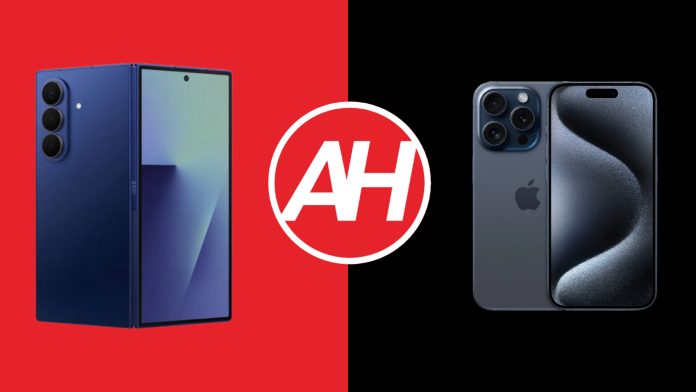We’ve compared the Samsung Galaxy Z Fold 7 with a lot of phones at this point. This is Samsung’s latest and greatest foldable, and it really is a considerable step up from the previous model. Well, we have another phone to compare it to, another one from Apple. In this article, we’ll be comparing the Samsung Galaxy Z Fold 7 vs Apple iPhone 15 Pro. A large-format foldable vs a powerful compact phone.
Needless to say, these two smartphones don’t really have a lot in common. They look vastly different while they even belong to different smartphone categories. That’s what will make this comparison rather interesting, though. We’ll first list their specs, and will then move to a number of other categories, including design, display, performance, battery, cameras, and audio. Let’s get to it, shall we?
Specs

Samsung Galaxy Z Fold 7

Apple iPhone 15 Pro
| Samsung Galaxy Z Fold 7 | Apple iPhone 15 Pro | |
|---|---|---|
| Dimensions (unfolded/folded) | 158.4 x 143.2 x 4.2mm / 158.4 x 72.8 x 8.9mm | 146.6 x 70.6 x 8.3 mm |
| Weight | 215 grams | 187 grams |
| Main display | 8-inch Dynamic AMOLED 2X (1-120Hz) | 6.1-inch LTPO Super Retina XDR OLED (1-120Hz) |
| Cover display | 6.5-inch Dynamic AMOLED 2X (1-120Hz) | N/A |
| Resolution | 2184 x 1968 / 2520 x 1080 | 2556 x 1179 |
| Chipset | Qualcomm Snapdragon 8 Elite for Galaxy | Apple A17 Pro |
| RAM | 12GB (LPDDR5X) | 8GB |
| Storage | 256GB/512GB (UFS 4.0) | 128GB/256GB/512GB/1TB (NVMe) |
| Main camera | 200MP (f/1.7 aperture, OIS, Quad Pixel AF, 0.6um pixel size, 85-degree FoV) | 48MP (wide, f/1.8 aperture, 1/1.28-inch sensor size, 1.22um pixel size, dual pixel PDAF, sensor-shift OIS) |
| Ultra-wide camera | 12MP (f/2.2 aperture, Dual Pixel AF, 1.4um pixel size, 120-degree FoV) | 12MP (f/2.2 aperture, 1/2.55-inch sensor size, 1.4um pixel size, PDAF) |
| Telephoto camera | 10MP (f/2.4 aperture, PDAF, 36-degree FoV, 3x optical zoom) | 12MP (f/2.8 aperture, 1/3.5-inch sensor size, 3x optical zoom, OIS) |
| Periscope camera | N/A | N/A |
| Selfie camera(s) | 10MP (f/2.2 aperture, 1.12um pixel size, 85-degree FoV) | 12MP (f/1.9 aperture, 1/3.6-inch sensor size, 1.0um pixel size, PDAF, OIS) |
| Battery size | 4,400mAh | 3,274mAh |
| Charging | 25W wired, 15W wireless, 4.5W reverse wireless (charger not included) | 23W wired, 15W MagSafe wireless, 7.5W Qi wireless, 4.5W reverse wired (charger not included) |
| Colors | Blue Shadow, Jetblack, Silver Shadow | Black Titanium, White Titanium, Blue Titanium, Natural Titanium |
Samsung Galaxy Z Fold 7 vs Apple iPhone 15 Pro: Design
The Samsung Galaxy Z Fold 7 features a glass back, while its frame is made out of aluminum. There is some titanium in the hinge, though. The iPhone 15 Pro has a glass back too, while its frame is made out of titanium. Samsung’s handset has sharper corners, while its front and back side, and its frame, are flat. The iPhone 15 Pro has rounded corners, while its frame is flat, as are the phone’s front and back side.
Samsung’s handset includes a display camera hole on both its main and cover displays. The power/lock and volume up and down keys are placed on the right-hand side. The iPhone 15 Pro has a pill-shaped cutout on the display, the so-called Dynamic Island. Its power/lock key is located on the right-hand side, while the volume up and down buttons are on the left. The phone’s Action Button sits on the left side, too.
The Galaxy Z Fold 7 includes three cameras on the back. They’re placed in the top-left corner, and vertically-aligned. Those cameras sit on a pill-shaped camera island, the whole setup does protrude on the back. Apple’s handset has three cameras on the back, and they also sit in the top-left corner. The thing is, the setup here is different, and you’ll be familiar with it if you’ve used a modern ‘Pro’ iPhone. Those cameras also protrude on the back.
The Galaxy Z Fold 7 is a considerably taller and wider phone, while it’s also heavier by 28 grams. That handset comes with an IP48 certification for water and dust resistance. The iPhone 15 Pro is IP68 certified.
Samsung Galaxy Z Fold 7 vs Apple iPhone 15 Pro: Display
The Samsung Galaxy Z Fold 7 features an 8-inch Foldable Dynamic LTPO AMOLED 2X panel. That display has an adaptive refresh rate (1-120Hz), and it supports HDR10+ content. The peak brightness here is 2,600 nits. The screen-to-body ratio is around 90%, while the display resolution is 2184 x 1968 pixels. The cover display measures 6.5 inches, and it’s a Dynamic LTPO AMOLED 2X panel. This one has an adaptive refresh rate of up to 120Hz too, while the Corning Gorilla Glass Ceramic 2 protection is included. The resolution this display offers is 2520 x 1080.

The Apple iPhone 15 Pro, on the other hand, has a 6.1-inch LTPO Super Retina XDR OLED display. This panel has an adaptive refresh rate (1-120Hz), whil HDR10 content is supported. Dolby Vision is supported too, while the peak brightness this display offers is 2,000 nits. The screen-to-body ratio is at around 88%, while the display aspect ratio is 19.5:9. The resolution this display offers is 2556 x 1179, while the Ceramic Shield glass protects this panel.
All three displays here are really good. They’re vivid, have great viewing angles, and they’re more than sharp enough. The crease on the Galaxy Z Fold 7’s main display is not as noticeable as you’d think. Samsung’s handset does lower brightness a bit too much in direct sunlight on very warm days, though, that’s something we’ve noticed. We’re not sure if it’s intentional, but it could be. Either way, we do hope that’ll get changed. All in all, all displays are really good.
Samsung Galaxy Z Fold 7 vs Apple iPhone 15 Pro: Performance
The Snapdragon 8 Elite for Galaxy chip, which is a 3nm chip from Qualcomm, fuels the Galaxy Z Fold 7. This is an overclocked variant of the standard chip, and Qualcomm’s most powerful offering at the moment. It is paired with 12GB of LPDDR5X RAM, while the phone also offers UFS 4.0 flash storage.
The Apple iPhone 15 Pro, on the flip side, comes with one of Apple’s chips. It’s fueled by the Apple A17 Pro, which is also a 3nm processor. It is no longer Apple’s best chip, however. That processor is paired with 8GB of RAM and NVMe flash storage. Neither phone supports storage expansion, by the way.
The performance is really good on both smartphones. They are very snappy during day-to-day use, and it’s really difficult to slow them down. They can jump between apps really fast, handle multimedia, messaging, browsing, and everything else without a problem. Even when it comes to gaming, both smartphones deliver. Yes, they do get quite warm when you push them, but they can handle pretty much any game you’ll find in their respective app stores.
Samsung Galaxy Z Fold 7 vs Apple iPhone 15 Pro: Battery
A 4,400mAh battery sits inside the Samsung Galaxy Z Fold 7. The iPhone 15 Pro, on the other hand, comes with a 3,274mAh battery. The Galaxy Z Fold 7 is a much larger smartphone, has two displays, not to mention that Android phones usually have larger batteries than their iPhone counterparts. With that in mind, that battery capacity in the Galaxy Z Fold 7 is not exactly high considering what it has to power.
Despite the fact it’s a smaller phone, the iPhone 15 Pro does offer better battery life in comparison. At least that was our experience. The difference is not huge, but it’s there. The Galaxy Z Fold 7 was able to cross the 7-hour mark for us, but most of the time it flew below that level. The iPhone 15 Pro can comfortably go over that level, most of the time. Your mileage may vary, though, of course.
The Galaxy Z Fold 7 supports 25W wired, 15W wireless, and 4.5W reverse wireless charging. The iPhone 15 Pro, on the other hand, supports 23W wired, 15W MagSafe wireless, 7.5W Qi wireless, and 4.5W reverse wired charging. Despite the fact that the Galaxy Z Fold 7 has a lower top speed of its charging, it still charges faster. Both smartphones charge in around an hour and a half, but the Galaxy Z Fold 7 is 5-10 minutes faster in that regard. Neither phone ships with a charger, by the way.
Samsung Galaxy Z Fold 7 vs Apple iPhone 15 Pro: Cameras
The Samsung Galaxy Z Fold 7 has three cameras on the back. A 200-megapixel main snapper (1/1.3-inch sensor size) is backed by a 12-megapixel ultrawide camera (120-degree FoV). The last camera on the back is a 10-megapixel telephoto unit (3x optical zoom). The iPhone 15 Pro also has three cameras on the back. A 48-megapixel main camera (1/1.28-inch sensor size) is backed by a 12-megapixel ultrawide unit (1/2.55-inch sensor size, 120-degree FoV), and a 12-megapixel telephoto camera (1/3.5-inch sensor size, 3x optical zoom).

Both of these main cameras are quite good. The Galaxy Z Fold 7 tends to take images that look more processed and more saturated, though. The iPhone 15 Pro’s images are closer to real life. Both phones do prefer warmer color tones, though, and both do a great job in both good lighting and back. The Galaxy Z Fold 7 has the edge with HDR shots, in our opinion, though. In low light, both phones are capable of brightening up the scenes and capturing enough details.
Their ultrawide and zoom cameras are a different story, though. The iPhone 15 Pro does a better job with its ultrawide camera, and the shots are closer to what the main camera provides. It also has the edge with the periscope telephoto camera, but only because the Galaxy Z Fold 7’s regular telephoto camera is not particularly good. Ultrawide and zoom cameras on these two phones are not exactly meant to be taking low light shots, they’re not particulary good in such scenes.
Audio
Both of these smartphones do feature stereo speakers. The ones on the iPhone 15 Pro are a bit louder, though. The sound quality is good on both ends, so not many people will complain about that.
Considering that there is no audio jack on either phone, you’ll need a dongle to hook up your wired headphones. The Galaxy Z Fold 7 supports Bluetooth 5.4, while the iPhone 15 Pro comes with Bluetooth 5.3 support.
#Samsung #Galaxy #Fold #Apple #iPhone #Pro

